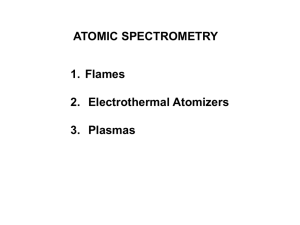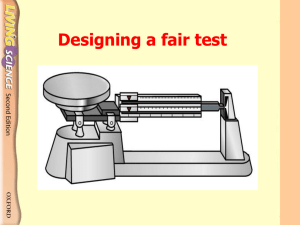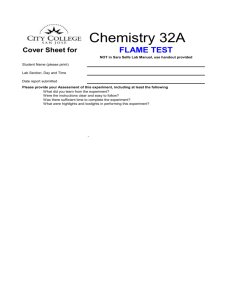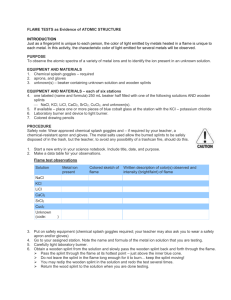Flame Test Lab Purpose
advertisement
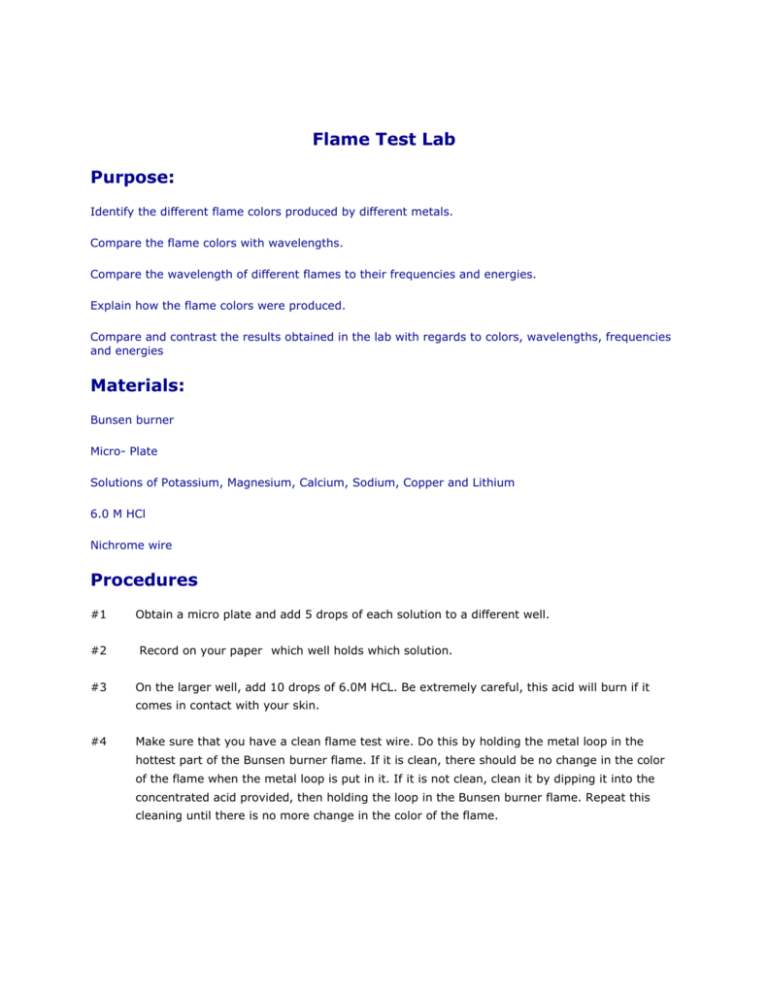
Flame Test Lab Purpose: Identify the different flame colors produced by different metals. Compare the flame colors with wavelengths. Compare the wavelength of different flames to their frequencies and energies. Explain how the flame colors were produced. Compare and contrast the results obtained in the lab with regards to colors, wavelengths, frequencies and energies Materials: Bunsen burner Micro- Plate Solutions of Potassium, Magnesium, Calcium, Sodium, Copper and Lithium 6.0 M HCl Nichrome wire Procedures #1 #2 #3 Obtain a micro plate and add 5 drops of each solution to a different well. Record on your paper which well holds which solution. On the larger well, add 10 drops of 6.0M HCL. Be extremely careful, this acid will burn if it comes in contact with your skin. #4 Make sure that you have a clean flame test wire. Do this by holding the metal loop in the hottest part of the Bunsen burner flame. If it is clean, there should be no change in the color of the flame when the metal loop is put in it. If it is not clean, clean it by dipping it into the concentrated acid provided, then holding the loop in the Bunsen burner flame. Repeat this cleaning until there is no more change in the color of the flame. #5 The next job is to do your flame tests. Dip the flame test loop into one of the known test solutions, and hold the metal loop in the hottest part of the Bunsen burner flame. Make a note of the color of the flame on your Flame Test Chart (like the one below). barium calcium copper magnesium potassium sodium #6 Clean the flame test wire, then test another known solution. Keep going until you have recorded the color of all of the known solutions. #7 Clean the micro plate by rinsing in water in the sink. Data analysis. #1 Match each of the colors observed to the wavelength chart on the board. Record this information on your paper. #2 Convert all wavelengths from nanometers (nm) to meters (m). Show your work. #3 Calculate the frequency corresponding to each wavelength. Show your work. #4 Calculate the energy (E) of a photon corresponded to each frequency. Show your work. #5 Record your this information in a data table. Questions #1 What particles are found in the chemicals that may be responsible for the production of colored light? #2 Why do different metals have different characteristic flame test colors? #3 How is spectrometry used to determine the composition of stars? DATA INFORMATION COLOR Violet WAVELENGHT (m) FREQUENCY (1/S) 4.22 x 10-7 7.1 x 1014 Blue 4.69 x 10-7 6.4 x 1014 Green 5.26 x 10-7 5.7 x 1014 COLOR WAVELENGHT (m) FREQUENCY (1/s) Yellow 5.77 x Orange 6.25 x 10-7 4.8 x 1014 10-7 4.3 x 1014 Red C = 3 x 108 m/s H = 6.626 x 10-34 J.s 1 nm = 1 x 10-9 m 6.98 x 10-7 5.2 x 1014 ENERGY (J) ENERGY (J)




